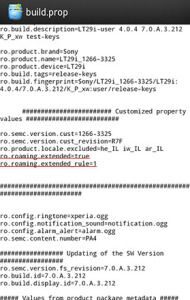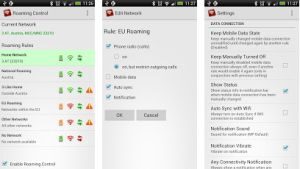

Esto significa que el teléfono está en itinerancia. ¿Es malo? no molesta bueno, alguien puede pensar que sí, aún cuando es puramente estético. ¿Me cobrarán más por estar en roaming? … Estas y otras preguntas las vamos a responder en el post de hoy.
Lo cierto es que si necesitas un poco en la red encontrarás mucha información al respecto. A modo de ejemplo la explicación dada por el Username Program at forum from gsmspain It is excellent and later I will put it:
There are users who use many of the MVNOs that we have in Spain. The curious thing is that depending on the mobile device to which we connect a certain SIM, we will obtain the R of ROAMING or not.
Why is this happening?
The SIM card has an identifier of the NETWORK to which it belongs. When you connect to an antenna with the same identifier, the connection is NORMAL, and when you connect to another because you don't have yours, you are in ROAMING.
The SIM also has prohibited identifiers, so, for example, a MoviStar card does not connect to a Vodafone, Orange or Yoigo network, even when it receives a signal from these three and not from MoviStar itself (if it is connected to this case, but it will only allow calling 112).
In MVNOs, the network identifier does not coincide with that of the antennas that are connected, but if one of the national operators is enabled. As an example, PepePhone uses Vodafone, so when it finds a Vodafone antenna it connects without problems, but as if it were ROAMING.
Why does the famous R appear on some mobiles and not on others?
Well, because in some mobile models an updated CSC package has been installed, for example in the Galaxy S2 most OMVs do not come out with R.
What does that CSC file do?
Al mismo tiempo de tener archivos de configuración APN de la mayoría de compañías dedicadas a la telefonía dispositivo móvil (MMS e Internet), cuenta con las antenas a las que pertenecen los ID de la tarjeta SIM.
So if the PEPHONE ID is 123 and in the CSC file it indicates that the ID 123 belongs to the Vodafone operator, when it is connected to a Vodafone antenna it will not show as ROAMING and it will not be necessary to activate the data in ROAMING .
Can I update the CSC file?
It will depend on the mobile device and its operating system. On Android, it's 100% sure you can.
Is it okay to try not to get that R?
If it is good, but it will really depend on the user, given that if it is a user who lives in Madrid and does not usually go out, they will never have problems, but someone who lives in Huelva, Badajoz, etc... would have to have data ROAMING activated to be able to connect to the Internet if the R appears, and later it could accidentally connect to any antenna in Portugal and we could be surprised with the bill.
The network ID is in turn made up of two codes.
ID = MCC / MNC
MCC has 3 digits.
MNC has 2 digits.
ID 21401 would correspond to:
MCC = 214
MNC = 01
What is MCC?
MCC uniquely identifies the country, in this way, all Spanish antennas and for Spanish operators will start with 214.
What is MNC?
MNC identifies the mobile device provider of the antenna, in other words, MoviStar, Vodafone, Orange, Yoigo...
What are the identification codes of Spanish operators?
214-01 = Vodafone
214-03 = Orange
214-04 = Yoigo
214-07 = MoviStar
These will be the codes of all Spanish antennas.
Now the SIM cards of these operators will have the same codes, while the OVM will have others.
What are the identification codes of the most famous MVNOs?
214-05 = OVM MoviStar (Tuenti)
214-06 = LMO Vodafone (PepePhone)
214-09 = LMO Orange (Simyo)
PepePhone SIM cards will have a 214-06 code and will connect to Vodafone's 214-01 networks as ROAMING.
Therefore, if you are one of the unlucky ones who encounters this problem, you should know that: firstly, it is something that has a solution and secondly, that the problem is caused by an outdated configuration of the operating system.
As I said at the beginning, this is a purely aesthetic obstacle and it occurs because the OMVs (depending on the version) require that you have the option to data roaming. As I said, this is basically cosmetic and not a problem unless you live near the border and the phone receives a better signal from the other country than from yours. For this case and having allowed the phone connect while roamingAny communication that requires data (Internet access) will cost you an arm and a leg.
Solution 1: Modify the build.prop file
NOTE: This fix on some ROMs has caused subsequent system malfunction.
To do so you need to have root access on your mobile device.

- Opens ES Explorer, root browser, root explorer or any other application that allows you to explore folders and files of the Android operating system.
- Find and open the folder system, and with a text editor edit the filebuild.prop (It is recommended to make a backup of this file. Root Explorer creates it automatically.)
- Look for the following section: # Custom Property Values #. If you don't have this section, you can create it yourself or skip to step 4. All lines in the file build.prop that start with a pound ('#') are lines of descriptions, it doesn't matter if they are or not, they just serve to better organize the file.
- Add the following lines to build.prop, already be al final del archivo o debajo # Custom Property Values # if you had it:
- ro.roaming.extended = true
- ro.roaming.extended_rule = 1
(Optional) If at the same time you want to be able to delete roaming and thus not always have it marked and avoid possible costs with foreign operators inadvertently, you must add these other two lines to the previous ones:
- ro.semc.enable.fast_dormancy = true
- ro.com.android.mobiledata = true
After this, logically, you must save the file and then restart your Android device.
Solution 2: File Modification spn-conf.xml
As in the previous solution, this other solution involves replacing the file spn-conf.xml What's inside /system/etc by one modified by us or by modifying ours.
In the same way, it is advisable to make a copy of that file in case something goes wrong when changing it.
In the archive it is very likely that you will find information about operators from various countries. If, for example, you are from Spain, focus on the 'spain' chapter since it is the one that affects you.
When you edit it, you will find a file that looks like this:

You should leave the file like this. Well, in fact, that you modify the line of your operator is enough.

Solution 3: Keep R but have tighter control with roaming.
If, as I have said previously, you live in a place close to the border and you do not want or do not dare with the two previous solutions, a good option would be to have more and better control over the issue of itineraries.
As we have previously explained, if your system is not up to date, you must activate roaming in order to use data with an MVNO. But a national roaming (which does not cost additional money) is not the same as roaming with a foreign operator and this is precisely what it monitors. roaming control.









